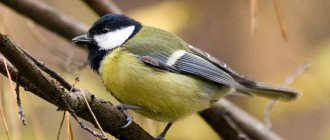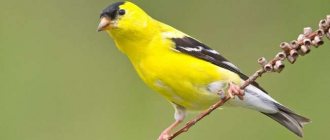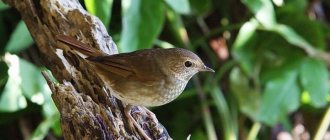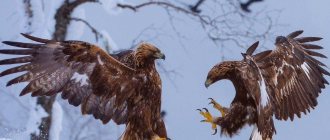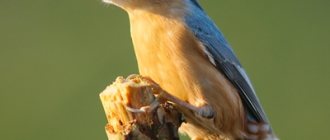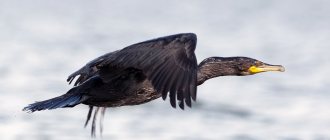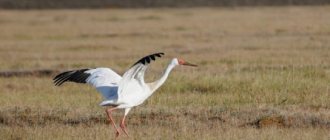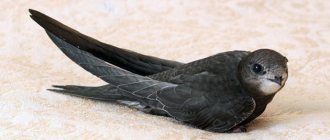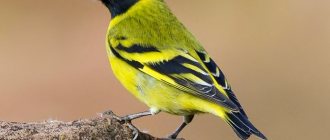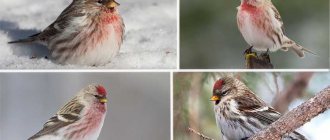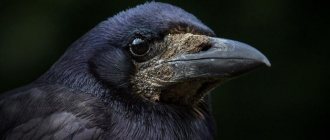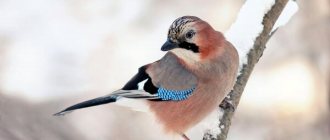Features and habitat of the finch
The finch bird is a member of the finch family. According to the description, the finch is a small bird about the size of a sparrow, sometimes reaching up to 20 cm in length, and weighing only about 30g. However, it differs significantly from other birds in that it has very bright plumage.
Males, especially during the mating season, look very defiant. Their neck and head are blue or dark blue. The chest, cheeks and throat are dark red or burgundy, the forehead and tail are black.
Two brightly colored stripes on each wing, and a green tail make the owner’s appearance unforgettable. After molting in the autumn, the color scheme of the bird's plumage becomes much more faded and brown tones begin to predominate.
The female finch has a more muted color, with gray-green shades predominating in her color. The juvenile chicks are larger in color than the females. There are many subspecies of finches; they differ among themselves in size, beak, color and other features. In some areas they occupy a leading place in number among other small birds.
Finches are considered migratory birds , although some representatives adapt and remain for the winter in their favorite territory. The European part of Russia, Siberia, and the Caucasus are their summer residence.
In September and October, birds gather in groups of approximately 50 to 100 individuals and go to winter in Central Europe, North Africa, Asia Minor, Kazakhstan and Crimea.
The photo shows a female finch
The finch can also winter in neighboring regions located further south. Birds fly to the South quickly, about 55 km/hour. Along the way, the flock may stop in regions rich in food for several days.
It can be said with firm confidence that, depending on the region, finches are sedentary, nomadic and migratory birds. In winter, finches form flocks and live mainly in open areas. As a rule, these are meadows and fields. Finches and sparrows are often members of their flock.
Finches arrive when spring is just beginning and can be observed in forests, groves, forest plantations and city parks. Favorite habitats are sparse spruce forests, mixed forests and light forests. In most cases they do not nest, since they usually look for food on the surface of the ground. Mostly they fly to the places where they were last summer.
The origin of the name of the bird is from the word freeze, chill. After all, they arrive at the very beginning of spring and fly away at the beginning of cold weather. There is one old Russian saying that if you hear the song of a finch, it means frost and cold, and a lark means warmth. It is noteworthy that the Latin name of the bird has the same root as the word cold. Our ancestors also believed that the finch is the herald of spring.
Male plumage color
The way the common finch looks deserves special attention. The older the bird, the brighter its plumage. Black forehead, bright blue neck, turning into red-brown, the same brick shade and chest. The brown back becomes greenish closer to the tail, and the lower part of the body has a contrasting white color. Those of the cover feathers that are the smallest are a beautiful dark blue color. Black wings with wide and narrow white stripes and yellow edging stand out very impressively. The lower tail coverts are pale white, edged with black scales. The gray tail feathers located in the middle have a yellow border, all the rest are black, covered on the inside with large white spots.
Around the light brown eyes there are rings of brown color. The male's beak changes color depending on the time of year. In the spring, during the mating season, it is bluish in color, and in winter it becomes completely brown.
Character and lifestyle of the finch
The common finch flies very quickly, and prefers to jump rather than walk on the surface of the earth. The songs of the finch are ringing, loud and highly variable individually, very similar to the trills of a lark, but have their own characteristics.
The duration of the chant is no more than three seconds, after a short pause it is repeated. Young animals perform simpler melodies, learn from adults and acquire skill and virtuosity with age.
By the way, each region is characterized by an individual “dialect”; the sounds made by the finch vary depending on where they live. The bird's repertoire can include up to 10 songs, which she performs in turn.
Before the rain, birds sing a peculiar trill “ryu-ryu-ryu”, so these birds can predict the weather. If a finch sings The finch's voice can be heard from the moment it arrives until mid-summer. In autumn, finches sing less often and “in a low voice.” At home, finch singing begins in January.
Listen to the voice of the finch
Nowadays, in order to hear the finch’s voice, many people strive to capture it at home. However, this is not the best solution. The finch does not really like to sing in a cage, it is constantly nervous, tries to free itself, and it may develop eye problems and obesity. In addition, choosing a diet for this bird is quite difficult.
Songs of the finch
The common finch is a beautiful bird that begins its trills in the spring and sings until summer. By the beginning of August, the finch's voice is heard less and less often. His song begins with a thin whistle and continues with a ringing, rolling trill. One or two beats sound, persistently repeated over and over again, and end with a characteristic sharp note.
Those who like to watch finches have long learned to distinguish between the knees. The birds sing for about five seconds, then fall silent for a moment and repeat it all over again.
With its songs, the common, or as it is also called - slender, finch is able to transmit certain signals to its fellows. Sounds can indicate fear, anxiety, aggression, attract a female, and also give a command to take off. Previously, decorative finches with an excellent voice could often be found in apartments, but today the bird is rarely bred at home.
Finch nutrition
The finch feeds on plant foods or insects. The bird's palate, strong beak and strong facial muscles make it easy to break both beetle shells and hard seeds.
Main diet: weed seeds and cones, buds and leaves, flowers, berries and all kinds of insects. Despite the fact that agricultural workers complain that birds destroy the seeds of sown plants, it is safe to say about the finch
What does a finch eat?
Photo: Zyablik in Russia
The finch menu consists of all kinds of insects and plants. Still, the former predominate in the bird's diet. Ornithological scientists who examined the contents of the finch's stomach found that it eats the seeds of various weeds and does not refuse berries and fruits. In summer, the menu mainly consists of animal foods. So, the plant diet of the finch includes: seeds of all kinds of weeds (nettle, quinoa), seeds of coniferous trees, various fruits and berries, buds of deciduous trees, flowers, foliage, cones.
The animal food of finches consists of: a variety of caterpillars, ants, flies, bugs, bedbugs, and larvae. Finches provide overwhelming assistance in the fight against insect pests such as weevils. The bird is very useful for both forest and agricultural land, because eats many pests of cultivated and wild plants.
The beak of this small bird is quite strong and strong, and the palate has unevenness. The finch's facial muscles are powerful, so it can handle even very hard food. A durable beetle shell, thick egg shells or elastic plant seeds are no obstacle for the finch. The finch searches for most of its food on the ground, moving along its surface in fast and frequent jumps.
Interesting fact: Only finches from their entire finch family feed their chicks only insects, without including other plant foods in their diet.
Reproduction and lifespan of the finch
In spring, male and female finches from warm regions in separate flocks. Males arrive earlier and stay away from their future mates. Then the males begin to sing loudly, these sounds resemble the chirping of chicks. These sounds lure females into their territory.
The mating season for finches begins in March. Before finding a mate, males occupy nesting areas, which have their own boundaries and different areas.
Often these are places where they nested last year. Competitors of the same species are immediately expelled from this territory. Fights between first-year males and older males over the outskirts of the old men’s territories are especially frequent.
During the mating period, male finch look like real bullies. They fuss a lot, fight among themselves and sing, often interrupting the song. At this moment he pulls himself up and the feathers on his head are pressed.
A nearby female flies up to the male, sits down next to him, bends her legs, raises her wings and tail a little, throws her head up and begins to quietly squeak “zi-zi-zi.” Such acquaintance can occur both on the ground and in tree branches.
A month later, the finches begin building their home. This task is entrusted to the female, the male’s concern is help. It has been estimated that when building a nest, the female descends to the ground at least 1,300 times in search of suitable materials. A finch nest can be found on almost any tree and at any height.
Most often - about 4 m and in the forks of branches.
How finches reproduce
Finches are monogamous during the breeding season, which lasts from September to February. Males occupy territory and sing mating songs in late July or early August. The females visit the males' territory and one of them eventually forms a pair bond with one of the finches.
However, this connection is not strong. The female may leave the territory during nest construction and mate with other males in nearby territories.
The female builds a neat cup-shaped nest from small grass, wool and moss, camouflaging the outside with lichen. The nesting site is located on a tree or bush at a height of 1-18 m above the ground. The female incubates the clutch alone for 11-15 days, and when the chicks hatch, both parents bring them food. The chicks are fed for about 3 weeks after fledging.
Finch bird: photo and description, lifestyle, habitat
There are countries in which bird watching tourism is widely developed. This is a whole science that has its amateurs and professionals. There is even a special term for it of English origin, which in the Russian manner sounds like “birding”.
Often people do not even notice those birds that live nearby. But in vain! Among ordinary birds there are quite attractive species, distinguished by their beautiful singing and bright colors.
Thus, the chaffinch can be found throughout Europe. The bird is quite unpretentious to its habitat, so it settles not only in forests, but also in city gardens and parks. If you make your own observations, you can find out whether the finch is a migratory bird or not. The answer will also be given in this article.
Why finch?
In order to understand the origin of the name, it is worth turning to Russian folklore. There is a sign that the lark sings for the onset of summer, and the finch for the return of frost. The bird arrives from wintering quite early, when spring has not yet fully come into its own. They immediately start singing. People began to say that the singing of a finch warns a person that he will have to chill, that is, he should wait for spring frosts. The bird's Latin name translates to "cool". Perhaps this means that cold weather will come for her.
According to another version, the finch was named so because when it sings in early spring, it abruptly ends its trills. It seems as if the cold has taken his breath away. This bird also trembles slightly while singing. But what does a finch bird look like?
Appearance
The species belongs to the Finch family. It is better to start describing the bird (finch) with the fact that it looks like a sparrow. Only its plumage is much brighter. Males, especially during the breeding season, have a blue head and neck. Their cheeks, throat, chest are burgundy, and their forehead is black.
There are light stripes on the black wings. The tail is dark in color with a green tint. By autumn, the color scheme fades and the color changes to a brownish color. The color of the female is dominated by gray-green tones.
There are many subspecies of finches. Each of them has distinctive features in appearance. For example, body size or beak shape.
Female plumage color
Adult females, unlike males, cannot boast such bright plumage. It is very important for them to be less noticeable during the period of hatching chicks, therefore the color scheme of females is calmer and more restrained. The plumage of the upper part of the body is dark brown in color, the lower part is slightly lighter, without sharp transitions.
The head and back of the head are greenish. The common finch differs quite a bit in color from an adult female in the first weeks of its life. The peculiarity of the chick's plumage is only a small white spot on the back of its head.
Features of accommodation
Finches are classified as migratory birds. Therefore, it is not correct to say that this is a wintering bird. The finch can adapt and stay for the winter if it has chosen a suitable place. Much depends on the region of residence. There are finches that are sedentary, nomadic, and migratory.
For wintering, it does not always leave the borders of one country. He may choose the southern region, where winters are milder. For migration, birds gather in flocks of 50-100 individuals. They fly at a speed of 55 kilometers per hour. Along the way, they can stop at areas rich in food. A few days later their flight continues. In wintering areas they live in flocks. Sparrows sometimes join them.
Finches return in early spring. They settle where there are trees - in forests, city parks, groves. They give preference to sparse spruce forests, light forests, and mixed forests. They often fly to the place where they were last summer. Such birds fly very quickly and jump on the ground.
Features of behavior
Birds live in pairs, trying to settle close to each other, while at the same time very jealously protecting their territory from neighbors. After the end of the nesting period, when the chicks grow up, the finches gather in large flocks, joining with other representatives of the finch family, and disappear from our area for the winter. Only some males remain for the winter.
The common finch, the description of its appearance given above, is a very energetic, dexterous, intelligent and unusually agile bird. Almost all daylight hours it is in continuous movement, only hiding in the branches of trees in the afternoon heat. The finch moves along the branches a little sideways, but jumps or runs quite quickly on the ground. Its flight resembles wavy lines, and it flies long distances at a considerable altitude. Before sitting down, the finch hovers above the ground for some time.
Singing
The finch is a bird that sings beautifully. Her songs are loud and sonorous. There are many variations of singing, depending on the individual characteristics of the species. The trills are similar to those performed by a lark.
The chant lasts three seconds. This is followed by a short pause and repetition of the chant. Young birds perform melodies that do not differ in any complexity. They learn from adults, gradually acquiring skill and improving their virtuosity.
The sounds that the finch makes differ depending on the region of residence. In total, his repertoire includes up to ten songs. He performs them one by one.
These birds can be used to predict not only the arrival of spring, but also the likelihood of rain. Before precipitation they perform “ryu-ryu-ryu”. By autumn the singing becomes quiet. This is most likely due to the end of the breeding season. The male no longer needs to attract the attention of his companion.
At home, the bird sings loudly from January to September. However, it is better not to keep her as a pet. Finches do not like to live in cages. They get nervous a lot, try to fly away, and may refuse to sing. In captivity, they are prone to obesity and eye problems. If such a bird does appear in the house, you should pay attention to its diet. It should be closer to natural. How do birds feed in the wild?
Nutrition
The finch bird eats both plant and animal foods. To do this, she catches various insects and looks for grain. Its beak is very strong. It is complemented by strong facial muscles. Therefore, the bird is able to break through the shell of a beetle or the shell of a seed.
The finch is not averse to eating the seeds that are sown in the fields. Agricultural workers often complain about them. But, eating a huge number of insects, they bring more benefits to both agricultural crops and forest plantations.
They destroy especially many insects during the period when the chicks appear. Finches feed them only protein foods. Which is not so common among birds of this family.
Reproduction
In the spring, finches, photos and descriptions of which are presented in the article, arrive in flocks, united by gender. Males return earlier. They stay separate from the females. The breeding process begins by luring female friends into their territory. To do this, males sing loudly. The sounds are similar to chicks chirping.
The mating season begins in March. Before luring a mate, males need to occupy a nesting site. Usually last year's place is chosen. If there are competitors near the nesting site, they are immediately driven out. Therefore, frequent fights occur between adults and first-year children.
During this period, males behave fussily, constantly fight, often interrupt their songs, and their plumage on the head is smoothed.
A female finch is nearby. She flies up to the male and sits next to him on a branch or on the ground. The female bends her legs and raises her wings and tail. Her head throws up, and a quiet “zi-zi-zi” comes from her beak. This is how a couple is formed.
A month later they begin to build their home. The female is considered to be the main one in this matter, and the male only helps. Researchers estimate that she picks up materials to build a nest from the ground. She goes down about 1300 times. The nest is built at a distance of four meters from the ground. Although the height and type of tree can be very different.
It takes a week to build the nest. Usually the nest has the shape of a bowl. The bird uses moss, thin twigs, grass, and roots as materials. The fastening is a web. The nest has rather thick walls - about two centimeters. The outer part is covered with moss, lichen or birch bark. The inside of the bowl is lined with feathers, down, and wool. Such a house cannot always be seen from the ground, thanks to good camouflage.
The female lays from 3 to 6 eggs. They have a greenish tint with irregular red spots. The female incubates them, and her partner brings food, showing care for her. But the male is not monogamous. He can find another female to mate with, not forgetting to take care of his offspring.
Nests and nesting of finches
During the period of gestation, these birds build themselves strong and solid nests in the shape of a bowl. A wide base, covered with branches and old leaves and a narrow bottom, growing at the crossroads of thick branches and as close to the trunk as possible. The bottom of the nest is dry and covered with down for the comfort of the chicks and the female hatching them.
Females take full responsibility for building the nest. Finches can fly from the construction site to the ground for material one and a half thousand a day!
Chaffinches lay eggs from the second half of May. The eggs themselves are pale turquoise or pale red with pink spots, one and a half centimeters in diameter. During incubation, the female rarely leaves the nest; she is fed by the male. And not always the same one who fertilized. Males are polygamous and can fertilize up to three females during the mating season. But the parental instinct of the fathers of finches is at its best. They protect and feed both their own and foreign chicks.
Finch nest with chicks
Finches hatch naked, red with sparse pale gray fluff on the head and back. The chaffinches are fed generously by both parents for two weeks, and the fledglings are fed for another 5-7 days when they have just fledged. Grown-up finches finally leave the nest in early June.
Finches have from 5 to 7 eggs in one clutch. The mortality rate of chicks is high, because those members of the family that live in the warmest latitudes can lay two clutches at intervals of two months. The second clutch contains only 3-4 eggs, but the finch family already has more experience in hatching offspring.
Young pairs of finches have particular difficulties finding a place for a nest. Often predators destroy the first homes, so the finches look for the most secluded corner to breed their offspring.
finch nest
Chicks
Chaffinch chicks are born two weeks after laying. They have visible red skin. Dark fluff covers only the back and head. The kids are helpless. Parents put insects in their beaks. During this period they should not be disturbed. Any outside interference will lead to the parents leaving the nest and the chicks to die.
By mid-June, the chicks are ready to leave the nest. The parents help the young birds for a few more weeks. By the end of summer, the pair may have a second brood. Only this time there will be significantly fewer eggs in the clutch.
Reproduction [edit | edit code ]
Finches arrive in early April. Nesting and laying begin in early May. Incubation and feeding time in the nest is two weeks. Young birds fled in June. Finches can lay two clutches per season. The second breeding is from June to August. Departure is from September to mid-October.
Finches are often polygamous—having fertilized one female, the male can mate with another. Although females take a greater part in caring for the chicks, males also participate in feeding (even if the chicks are the offspring of another male), guard the territory, and warn of the presence of a predator (an alarm call or the sound of “hyut-hyut”
).
Features of masonry [edit | edit code ]
The clutch consists of 4-7 eggs, colored pale bluish-green or reddish-green with pinkish-purple spots. Egg dimensions: (17-23) × (13-15) mm.
Nesting sites [edit | edit code ]
The finch nests in various forests, gardens and parks. It gives clear preference to sparse spruce forests and areas of mixed forest, as well as dry light pine forests, especially if there are groups of deciduous trees and shrubs nearby. Avoids dense overgrown places, as it often descends to the ground to feed.
Nest location [edit | edit code ]
Finches' nests are usually located on trees of various species at different heights from the ground: from 1.5 to 15 m, but more often at a height of 2-4 m. On deciduous trees, the finch places a nest at the base of a side branch extending from the main trunk; on spruce or pine trees - usually on a horizontal branch among the needles at a distance from the trunk, less often near the main trunk.
Nest building material [ edit | edit code ]
The construction of finches' nests is varied:
- Blades of grass and twigs form only the basis of the walls and bottom, and the entire thickness is made of moss.
- There is as much moss as there are blades of grass and twigs.
- Blades of grass and twigs predominate.
The outside walls of the nest are lined with lichens, birch bark, pieces of bark and lumps of plant fluff. The lining of finches' nests is varied: in some nests pieces of lichen predominate, in others - birch bark, in others - there may be equal amounts of both. Plant fluff is also present to varying degrees, but it is always less than birch bark and lichens. All building material is firmly fastened with spider web threads, due to which the walls acquire greater density. The litter in the nest is made of feathers, wool, and sometimes from the golden threads of the stalks of cuckoo flax. The lining perfectly camouflages the nest, and it is not easy to spot it against the background of tree bark or among pine needles.
Shape and dimensions of the nest [edit | edit code ]
The finch's nest is a dense, deep cup, woven mainly from dry blades of grass, thin twigs and moss. The diameter of the nest is 90-105 mm, the height of the nest is 50-80 mm, the diameter of the tray is 50-70 mm, the depth of the tray is 30-50 mm.
Lifespan
Finches are forest birds that look for food for themselves and their chicks on the ground. They are often victims of predators. Perhaps that is why they do not live long. Although in captivity their life expectancy is up to twelve years.
They are found very often in nature, so they are not rare or endangered species. Finches do not pose any danger or value to humans and do not cause harm. That is why you will not find them in the Red Book. Although there are many beautiful pictures of males with bright colors on the Internet. This suggests that the bird is popular among ornithologists.
Keeping a finch in captivity
In the old days, these birds were kept in cages quite often, and they were very expensive. At the same time, a finch that finds itself in captivity takes a long time to get used to the new environment and does not immediately begin to sing. Surprisingly, birds in captivity have a much longer lifespan than in nature. Despite this, they are not very suitable for keeping in an apartment and in extremely rare cases they become accustomed to humans.
The singing ornamental finch, the photo of which is posted below, is capable of emitting its sonorous trills only as long as the person next to it is motionless.
As soon as you move a little, the singer begins to throw himself against the walls of the cage, hitting the bars and risking breaking. Therefore, in order to prevent the birds from being injured, the finches are kept one at a time, making sure to cover the cage with a linen blanket.
Often the finch, waking up at night, begins to jump on the perches, but, unable to see in the dark, bumps into the walls. It has been noticed that such behavior is characteristic of these recluses when the migration period begins for migratory birds. To avoid disturbance at night, it is recommended to turn on a small light at night so that the bird can see the perches and twigs.
Many problems arise with the diet of finches kept in captivity. In addition, they often suffer from obesity and eye diseases. For these reasons, the number of people willing to listen to captive finches sing has decreased significantly.
Finch bird. Description, features, lifestyle and habitat of the finch
The finch, which belongs to the genus of finches, is called the bullfinch, chaffinch, and zyabok. In most of the range, birds return from the South by the end of March, when the snow has not yet melted everywhere. People say that in early spring the finch sings in anticipation of frost.
But this is not the only version of the origin of the name. The ruffled appearance and the abrupt end of the trill suggest that the bird is chilling and is taking its breath away from the cold.
Description and features
In most of the Russian Federation, former Soviet republics, countries of Western Europe and the Middle East, the most common finch is the European finch. Its long 11-mm sharp beak is brown, except during the mating season, when a blue tint appears.
The entire lower part, throat and cheeks are brownish-brown or wine, the back is a shade lighter. The neck and cap on the head of the finch are gray-blue in color; a contrasting black spot stands out above the beak.
Just below the back, the colors include yellow and green tones. The wings are outlined with a white border. White spots located diagonally are present on the sides of the tail. Such intense coloring adorns males starting from the second year of life.
The finch in the photo in its breeding plumage looks elegant. Females and older chicks are much paler and more expressionless. Brown and grayish tones predominate. The average body length of the European finch is 16 cm, tail - 7 cm, weight 22 g.
Despite the fact that the bird flies quickly, it spends most of its time on the ground, moving in leaps and bounds in search of food. Because of this, they often die from attacks by predators.
The finch's sounds and calls are attractive. In different situations - in case of danger (“sii”, “hyut”, “tew”), take-off (“tyup”), courtship (“xip”), begging (“chirrup”) the bird makes up to seven signals. For a long time it was believed that finches warn of rain with the sound “ryu-ryu”. But recent observations have shown that there is no connection between the “rumbling” and the weather phenomenon. The signal corresponds to the bird's alarm state.
If an individual performs 3–6 melodies, then the population numbers up to twenty. The finch's singing begins with a whistle, turns into trills, repeated every three seconds, and ends with a sharp, abrupt sound - a flourish. Melodies vary depending on the subspecies and habitat.
The older the male, the more varied his roulades, since experience accumulates over time and is adopted from relatives and other species. Females and grown chicks are only capable of simplified, monotonous sounds. If in the spring a bird sings loudly and willingly, then by mid-summer the molting period begins and it is rarely heard. The melodies sound muffled.
The systematization of finch subspecies includes 18 names. Distinctive features are size, plumage color, distribution area. In addition to the described European finch, 3 more subspecies are found on the territory of the Russian Federation and the former Union republics:
In summer, the finch lives in the Crimea and the Caucasus. In winter it is found in northern Iran and southern Transcaucasia. It settles in the forests of the foothills and mountains at an altitude of up to 2.5 thousand meters above sea level. Body length up to 13 cm, massive high beak, coloring like the European one. Distinctive features are a calling “kick” cry, more like the call of a great tit, and less attractive vocal characteristics.
The undergrowth is dark in color, small in shape. Settlements were found in northern Iran, nesting in the southern regions of the Transcaspian region. The back is dark brown, the underside has a red tint, the head and neck are dark ash.
The bird is pale, with voluminous areas of white color on the tail and wings. The distribution area is the territory of the Turkmen highlands of Kopetdag. Ornithologists assume that this subspecies is a variation of the Hyrcanian finch.
What types of finches are there and their differences
Finches and all representatives of finches are one of the most branched and numerous species of birds.
The most typical species for Europe and Russia is the European finch (Fringilla coelebs). It is distinguished by a black spot above the beak and a green back at the base of the tail. They are equal in size to a sparrow and live on the territory of the European and Russian plains. They winter in the south of the Caucasus, Middle Asia and the Arabian Peninsula.
The Caucasian finch (Fringilla coelebs solomkoi) is common in the region of the same name in the Caucasus, its foothills and in the Crimea. It is distinguished by a darker color, slightly larger size compared to its European relative and a long, hard beak. With its help, the Caucasian finch extracts food from cracks in the rocks. They nest there, and the shelters of mountain finches turn out to be somewhat more reliable than their European counterparts. For the winter it flies to Iran and the south of the Caucasus, settling in the foothills at an altitude of 2.5 meters above sea level. The singing of the Caucasian finch has more of a “kicking” note with a slightly muted tint and is less attractive than that of its European counterpart. So a hard, long beak and life in the mountains have their drawbacks for warblers.
The Kopetgagh finch (Fringilla coelebs transcaspia), an inhabitant of Iran, has the palest color among its species: a fawn belly, an ashy head and a pale brown back with white spots on the wings and tail. For such colors, the feathered resident of the Kopetdag Valley is popularly called the “white finch.” Its ancestor is the Hyrcanian finch.
The Hyrcanian finch (Fringilla coelebs alexandrovi) is basically a dark and pale gray plumage with a brown back and a slightly reddish belly. The Hyrcanian species is smaller in size compared to other representatives of the finch family. It lives in Iran and in the south of the Caspian Sea, preferring to nest in the latter.
The blue finch (Fringilla teydea) is endemic to the islands of Tenerife and Gran Canaria. The slang name reflects the fact that the color of this species has a predominantly blue tint. Listed in the Red Book under the heading “Endangered”.
Photo of blue finch
The finch (Fringilla montifringilla) is the closest relative. It has a common color and body shape with it. A reddish pink belly, a dark gray back and a wider “cap” of dark gray color with black streaks. The flight wings and tail are black with white stripes along the edges of the flight and tail feathers. The beak is dark gray and black with a yellow base. Female finches are predominantly gray, with similar colored beaks and flight feathers.
Photo of a finch
Nutrition
In the wild, parents feed chicks with larvae, caterpillars, dipterans, and arachnids. Vegetable food, the amount of which increases during prolonged rains or late nesting periods, includes:
- seeds, tops of pine and spruce seedlings;
- oats;
- bearberry, irga.
the adult common finch flies to garden plots to eat berries. Loves the seeds of sorrel, elderberry, violet, bird buckwheat, and primrose. A little later, the seeds of weeds (nettle, quinoa) ripen, which the bird consumes before flying off for the winter.
In the spring-summer period, most of the diet consists of protein foods;
Green parts of plants, flowers, and buds were found in the stomachs of birds. The finch is useful for forestry and agriculture, as it rids forests and crops of insect pests.
Chaffinch chicks
At one time, a female finch lays four to seven eggs. They do not exceed 2 centimeters in size and have a blue-green tint with pink splashes. For 11-13 days, the expectant mother incubates the offspring, while the future father feeds her. It’s true that he doesn’t do this often; he mostly sings and gets into fights with neighbors who fly into the nesting area. In one season, a female can lay eggs twice.
Newborn chicks are fluffy and soft. The body is covered with gray down, only the forehead and chest remain bald. But on the head there are feathers sticking out in different directions, reminiscent of a funny hat. After two weeks, the babies fledge and become like their mother. As a rule, both parents feed them. They bring insects, larvae, and mosquitoes, but the majority of their diet consists of caterpillars. After a month, the small finches switch to plant foods, become independent and leave their parental nests.
If you liked this article, like it and write your observations in the comments. We'd love to read your thoughts on finches.
+1
